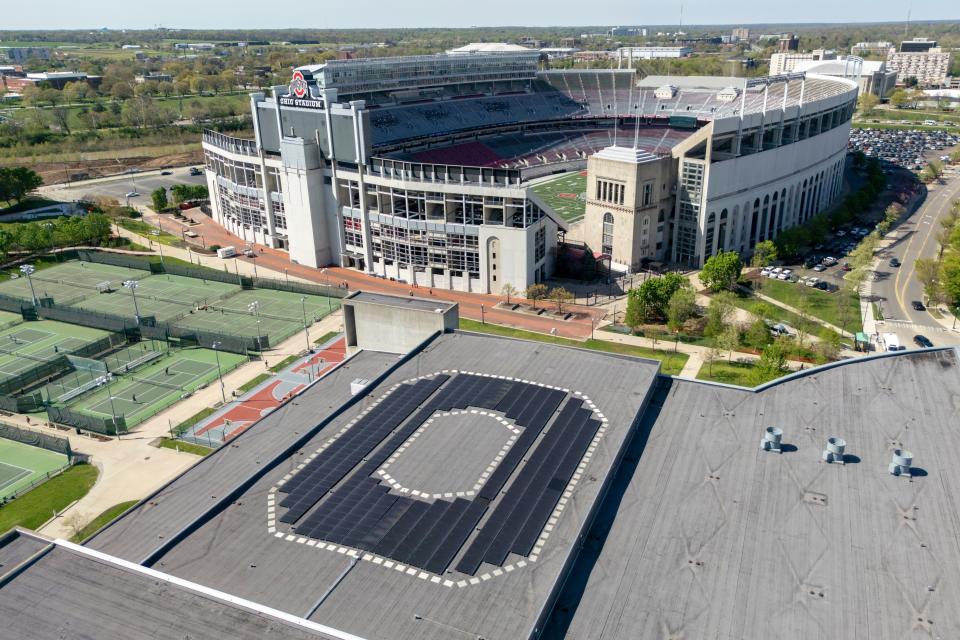On Earth Day, why is Ohio State struggling to meet sustainability goals?
In 2015, Ohio State University adopted a new slate of sustainability goals aimed at, among other things, being a better steward of its resources.
The goals, both specific and ambitious, built on a previous 2008 commitment to achieve carbon neutrality by 2050 and its first Climate Action Plan, which was published in 2011.
"Global climate change presents a clear threat to communities across the globe," former Ohio State President Michael V. Drake said in 2020 as the university reaffirmed its goals and path to carbon neutrality.
"Ohio State is committed to take actions that advance scientific knowledge and social understanding, and model operational techniques that will propel new solutions to climate change," he said.

Nearly a decade later, those goals are not close to being accomplished.
"We are not being as aggressively successful as we hoped," Jay Kasey, OSU senior vice president of administration and planning, told OSU trustees at a Master Planning & Facilities committee last November.
Kasey updated trustees on six of the eight goals, all of which were below target. At the time, he said five of the six goals were in the "yellow" category, meaning OSU made progress since last year, but didn't quite hit the goal. One goal was in the "red" category, indicating no progress.
The resource stewardship goals include:
Achieve carbon neutrality by 2050 per Presidents’ Climate Leadership Commitment;
Increase the energy efficiency of the university by 25% per building square foot by 2025;
Reduce potable water consumption by 10% per capita every five years (to be reset every five years);
Increase Ecosystem Services Index score to 85% by 2025;
Reduce carbon footprint of university fleet per thousand miles traveled by 25% by 2025;
Achieve Zero Waste by 2025 by diverting 90% of waste away from landfills.
Two goals that were not discussed included plans to increase production and purchase of locally and sustainably sourced food to 40% by 2025, and to develop university-wide standards for targeted, environmentally preferred products and fully implement preferable products and services by 2025.
Ohio State says sustainability goals are ‘aspirational in nature’
Kasey pointed to reasonable progress on five of the goals, like green space enhancements across campus and the addition of five new electric vehicle charging stations.
While the university has made meaningful strides on almost all of it sustainability goals since 2015, Kasey said in November it will need to reevaluate where to go next after the goals expire next year. He told trustees that he would bring them an update at its May board meeting.
Kasey was unavailable to speak with The Dispatch to discuss what the updated future of Ohio State's sustainability goals might look like.
University spokesman Ben Johnson said most of Ohio State's current goals are "aspirational in nature."
"While some efforts fell short of these lofty goals, it is also true that the university made tangible sustainability improvements," Johnson said. "Ohio State continues to work toward a more sustainable campus and will consider future goals and targets."

Can a college truly be carbon neutral?
The university has made efforts to curb energy consumption, increase green spaces, reduce waste and reduce its carbon footprint.
Since 2015, Ohio State has planted more than 3,000 trees, reduced energy used per square foot by 12.7%, and increased the amount of waste diverted from landfills to 41%. Among its most aspirational goals, Ohio State says its reduced its carbon footprint by 31%.
Experts say that some progress is better than no progress. But with Ohio State being so far off path on its goals, it begs the question: Can a college truly attain carbon neutrality?
The answer is yes, experts say, but it can get a little complicated.
Alex Barron, an associate professor of environmental science and policy at Smith College in Massachusetts, said a wave of higher education institutions between 2007 and 2008 signed the American College and University Presidents’ Climate Commitment, pledging to “achiev[e] carbon neutrality as soon as possible.”
Ohio State signed on in 2008. Since then, more than 800 U.S. colleges and universities have signed the commitment, which acknowledges that climate impacts will only worsen as long as more greenhouse gas emissions enter the atmosphere rather than leave it.
Schools report their progress to Second Nature, a Boston-based sustainability nonprofit which oversees the Presidents' Climate Commitment. But Barron said more accountability is necessary to make sure institutions see their goals through.
"In order for schools to be held accountable, someone needs to be paying attention and asking questions," Barron said, whether that's students, faculty, trustees or community members.
"It is work to meet our climate goals," he added. "It takes sustained commitment and discipline."
According to Second Nature, 11 universities and colleges in the United States had achieved carbon neutrality since 2021: Allegheny College, American University, Bates College, Bowdoin College, Colby College, Colgate University, Colorado College, Dickinson University, Green Mountain College, Middlebury College and the University of San Francisco.
Many schools are on the path toward carbon neutrality, but they aren't doing so by actually cutting emissions on campus, said Timothy Gutowski, a professor of mechanical engineering at the Massachusetts Institute of Technology.
Rather, Gutowski said some schools are relying on buying carbon credits — where an entity pays a company to reduce its greenhouse gas emissions — to get the job done.
"While certainly well-intended, it's questionable if you're getting the amount of carbon you're buying," he said. "It calls effectiveness into question."
Barron agreed.
"We can't move toward carbon neutrality if we're just paying others," he said. "People need to have a plan to grapple with their own emissions."
What can universities do to make more sustainable goals?
Gutowski said he applauded Ohio State for its honesty in its progress toward sustainability goals.
"It's a teaching moment," he said. "It's not as easy as people want to claim."
As the university evaluates it's next steps, Gutowski said it's better to be realistic than aspirational. He said he deals with this on a regular basis with his students as they grapple with their own sustainability goals.
"I'm always on the side of realism," Gutowski said.
Barron said that while carbon neutrality is a meaningful goal, it's important for university leaders to have a "right order of operations." That starts by dealing with your campus' own greenhouse emissions before looking to carbon offsets.
"Colleges won't achieve their goals without planning, a real commitment and funding," Barron said.
Sheridan Hendrix is a higher education reporter for The Columbus Dispatch. Sign up for Extra Credit, her education newsletter, here.
@sheridan120
This article originally appeared on The Columbus Dispatch: Ohio State falls behind on sustainability, carbon neutrality goals

